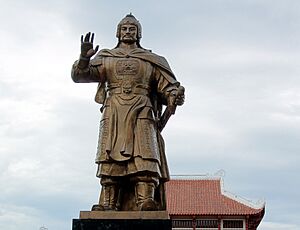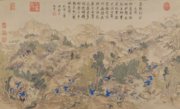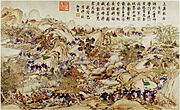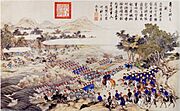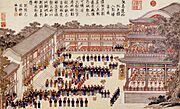Battle of Ngọc Hồi-Đống Đa facts for kids
Quick facts for kids Qing invasion of Đại Việt |
|||||||
|---|---|---|---|---|---|---|---|
| Part of Tây Sơn wars and Ten Great Campaigns | |||||||
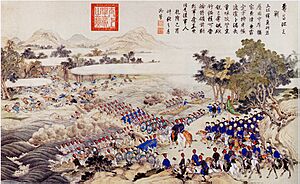 A depiction of the Battle at the Thọ Xương River (present-day Thương River), engraving, co-produced by Chinese and European painters. |
|||||||
|
|||||||
| Belligerents | |||||||
Lê dynasty |
Tây Sơn dynasty | ||||||
| Commanders and leaders | |||||||
Lê Chiêu Thống Hoàng Phùng Nghĩa |
Nguyễn Huệ Phan Văn Lân Ngô Văn Sở Nguyễn Tăng Long Đặng Xuân Bảo Nguyễn Văn Lộc Nguyễn Văn Tuyết Đặng Tiến Đông Phan Khải Đức Nguyễn Văn Diễm Nguyễn Văn Hòa |
||||||
| Strength | |||||||
|
20,000–200,000 Chinese troops Perdue: 10,000 Chinese and 100,000 Le loyalists (militia) |
100,000 (50,000 regulars, 20,000 newly recruited militia) 100-300 battle elephants 350 cannons |
||||||
| Casualties and losses | |||||||
| Charles La Mothe claims: 40,000–50,000 killed? At least 3,400 prisoners |
Over 8,000 killed | ||||||
The Battle of Ngọc Hồi-Đống Đa was a major fight in northern Vietnam. It happened between the Vietnamese Tây Sơn dynasty and the Qing dynasty of China. The battle took place from 1788 to 1789. It is also known as the Qing invasion of Đại Việt or the Victory of Kỷ Dậu. The battle ended with the Chinese army leaving Vietnam. They had tried to put the last Lê emperor, Lê Chiêu Thống, back on his throne. But the Tây Sơn forces, led by Nguyễn Huệ, stopped them. This victory is seen as one of the most important in Vietnamese military history.
Contents
Why Did the Battle Happen?
Vietnam's Divided Past
For a long time, since the 1600s, Vietnam was split into two parts. The southern part, called Đàng Trong, was ruled by the Nguyễn lords. The northern part, Đàng Ngoài, was controlled by the Trịnh lords. They ruled under the Lê emperors, who had very little real power.
In 1771, a big uprising started in southern Vietnam. This was the Tây Sơn rebellion. It was led by three brothers: Nguyễn Nhạc, Nguyễn Huệ, and Nguyễn Lữ. They took power from the Nguyễn lords.
Nguyễn Huệ's Rise to Power
After taking the city of Phú Xuân (now Huế), Nguyễn Huệ was encouraged to move north. He marched to Thăng Long (modern Hanoi) and took control. In 1788, he put Lê Chiêu Thống on the throne as the new Lê emperor. Then, Huệ went back to Phú Xuân.
However, Lê Chiêu Thống soon lost power. Nguyễn Huệ sent an army to Thăng Long again. Lê Chiêu Thống had to run away and hide. Nguyễn Huệ then put his own generals, Ngô Văn Sở and Phan Văn Lân, in charge of the north.
China Gets Involved
Lê Chiêu Thống still wanted his throne back. He and his family went to China to ask for help. The Chinese Qianlong Emperor decided to send a large army to Vietnam. Their goal was to put Lê Chiêu Thống back in power.
Historians disagree on why China got involved. Some Chinese scholars say the emperor only wanted to help Lê Chiêu Thống. They say China did not want to take over Vietnamese land. But Vietnamese scholars believe China wanted to make Vietnam a smaller, controlled state. They think China planned to keep troops in Vietnam and have Lê Chiêu Thống rule as a puppet king.
The Chinese Invasion Begins
Two Armies Attack
In late 1788, two large Chinese armies invaded Vietnam. One army, led by Sun Shiyi, came from the Liangguang region. They crossed the Friendship Pass. The other army, led by Wu Dajing, came from the Yungui region. They crossed the Horse Pass. Both armies planned to march straight to Thăng Long.
The size of the Chinese army is not clear. Some reports say it was as many as 200,000 or even 300,000 soldiers. Other reports say it was much smaller, around 36,000 Chinese soldiers plus Vietnamese supporters.
Tây Sơn Retreats
Sun Shiyi's army quickly reached Lạng Sơn. He spread rumors that his army was even bigger than it was. He also promised rewards to anyone who helped the Chinese. Because of this, many supporters of the Lê dynasty joined the Chinese.
The Chinese defeated the Tây Sơn army in Lạng Sơn. Some Tây Sơn generals fled or surrendered. The Chinese pushed quickly south. The Tây Sơn forces were not ready and scattered. General Ngô Văn Sở realized his army could not stop the Chinese. He decided to pull back to Tam Điệp. He sent a message to Nguyễn Huệ in Phú Xuân, asking for help.
On December 16, 1788, the Chinese army crossed the Nhị River (now the Red River). They took Thăng Long the next morning without a fight. On December 21, 1788, Sun Shiyi officially made Lê Chiêu Thống the "king of Annam" in Thăng Long. Lê Chiêu Thống was not popular with many Vietnamese.
Tây Sơn Fights Back
Nguyễn Huệ Becomes Emperor
On December 21, 1788, Nguyễn Văn Tuyết reached Phú Xuân with the news. Nguyễn Huệ declared Lê Chiêu Thống a traitor. The very next day, Huệ declared himself Emperor Quang Trung. After his coronation, he marched north with about 20,000 soldiers. Along the way, he gathered more volunteers. His army grew to about 100,000 troops.
In Thanh Hóa, he gave an inspiring speech to his soldiers. He told them to fight bravely for their country's freedom. His soldiers were very motivated and marched quickly. The Chinese generals, feeling too confident after their easy victories, did not think the Tây Sơn army was a threat.
Planning the Surprise Attack
Nguyễn Huệ reached Tam Điệp on January 15, 1789. He approved of the plan to attack the Chinese. He divided his forces into five groups.
- The main force, led by Huệ himself, would march directly to Thăng Long.
- A navy led by Nguyễn Văn Tuyết would attack Lê supporters in Hải Dương.
- Another navy led by Nguyễn Văn Lộc would attack other areas.
- A cavalry group with war elephants, led by Đặng Tiến Đông, would attack Chinese forces in Đống Đa.
- Another cavalry group with war elephants, led by Nguyễn Tăng Long, would attack Chinese forces near Thanh Trì.
The Great Battle
The Chinese armies decided to celebrate the Chinese New Year festival. They planned to attack Phú Xuân later. The Vietnamese New Year (Tết) is usually celebrated on the same day. The Chinese generals thought the Tây Sơn army would not attack during the holidays. But they were wrong.
The Tây Sơn army crossed the Hoàng Long River on New Year's Eve. They silently removed all Chinese scouts. The Tây Sơn army reached Thăng Long on the night of January 28, 1789. They immediately launched a surprise attack. The Chinese soldiers were celebrating the New Year and were caught off guard.
Taking the Forts
The Tây Sơn army surrounded the city. They used heavy cannons carried by elephants. They broke through the forts. Nguyễn Huệ's soldiers shouted for the Chinese to surrender at Hà Hồi Fort. The Chinese army was scared and ran away in the dark.
At dawn on January 30, 1789, Huệ attacked Ngọc Hồi Fort. The Chinese inside the fort fired their weapons. But the Tây Sơn soldiers used large, wet wooden shields to protect themselves. Nguyễn Huệ, riding an elephant, led his men from the front. The war elephants broke through the fort walls. Tây Sơn soldiers entered and fought with daggers. They quickly captured other forts like Văn Điển and Đống Đa.
Qing Defeat and Retreat
The Chinese forces were completely defeated. They scattered and fled in confusion. When Sun Shiyi heard his army was beaten, he ran away with a few men. While crossing the Nhị River (Red River), he lost his official seal. Tây Sơn soldiers later found it and gave it to Nguyễn Huệ. Lê Chiêu Thống also fled to China. Many Chinese generals were killed in the battle, and countless soldiers drowned trying to cross the river.
Nguyễn Huệ and his main force quickly entered Thăng Long and took back the city. The other Chinese army, under Wu Dajing, heard about Sun's defeat. Wu decided to retreat to China. His army was ambushed by local Tày people, but most of his soldiers made it back safely.
Because of his quick victory, Nguyễn Huệ was called "new Attila" or "new Alexander" by some people at the time.
What Happened Next?

Seven days later, Sun Shiyi arrived in China. He met Lê Chiêu Thống there and promised to help him gather new troops. But the Qianlong Emperor was angry. He replaced Sun Shiyi with a new general, Fuk'anggan.
Fuk'anggan did not want more fighting. He sent a letter to Nguyễn Huệ, asking for an apology. Nguyễn Huệ wanted to make peace with China. He sent a respectful request to the Qianlong Emperor. He wanted to restart the "tributary relationship." This meant Vietnam would send gifts and show respect to China, but China would recognize Vietnam's independence. This would also stop China from trying to restore the Lê dynasty again.
In 1789, the Qianlong Emperor agreed. He recognized Nguyễn Huệ as the legal ruler of Vietnam. He even asked Huệ to visit Beijing for his 80th birthday. Nguyễn Huệ sent someone else to go in his place. The emperor accepted this and gave Nguyễn Huệ the title "King of Annam." This meant Lê Chiêu Thống was no longer supported by China.
Nguyễn Huệ was still angry at the Qing dynasty. He continued to train his army and build warships. He even gave shelter to groups who were against the Qing in China. However, he died in 1792 before he could launch another attack.
Later, the Nguyễn lords gained support from Chinese communities in Vietnam. They eventually defeated the Tây Sơn dynasty and took control of all Vietnam in 1802. They then started the imperial Nguyễn dynasty.
Why This Battle is Important
The Battle of Ngọc Hồi-Đống Đa is one of the greatest military victories for the Vietnamese people. In China, it is remembered as one of the "Ten Great Campaigns" during the reign of the Qianlong Emperor.
This Vietnamese victory showed that the Qing Chinese could be defeated. It is thought that this event might have stopped China from trying to invade other parts of Southeast Asia. Emperor Quang Trung, Nguyễn Huệ, is now a national hero in Vietnam. His image has appeared on money, and many streets and temples are named after him.
Gallery
See also
- Đống Đa Mound
- Battle of Rạch Gầm-Xoài Mút
- Tây Sơn military tactics and organization
- Ten Great Campaigns
- Draft History of Qing
- Đại Nam thực lục
- Sino-Burmese War (1765–69)
- Ming conquest of Đại Ngu
- Mongol invasions of Vietnam


